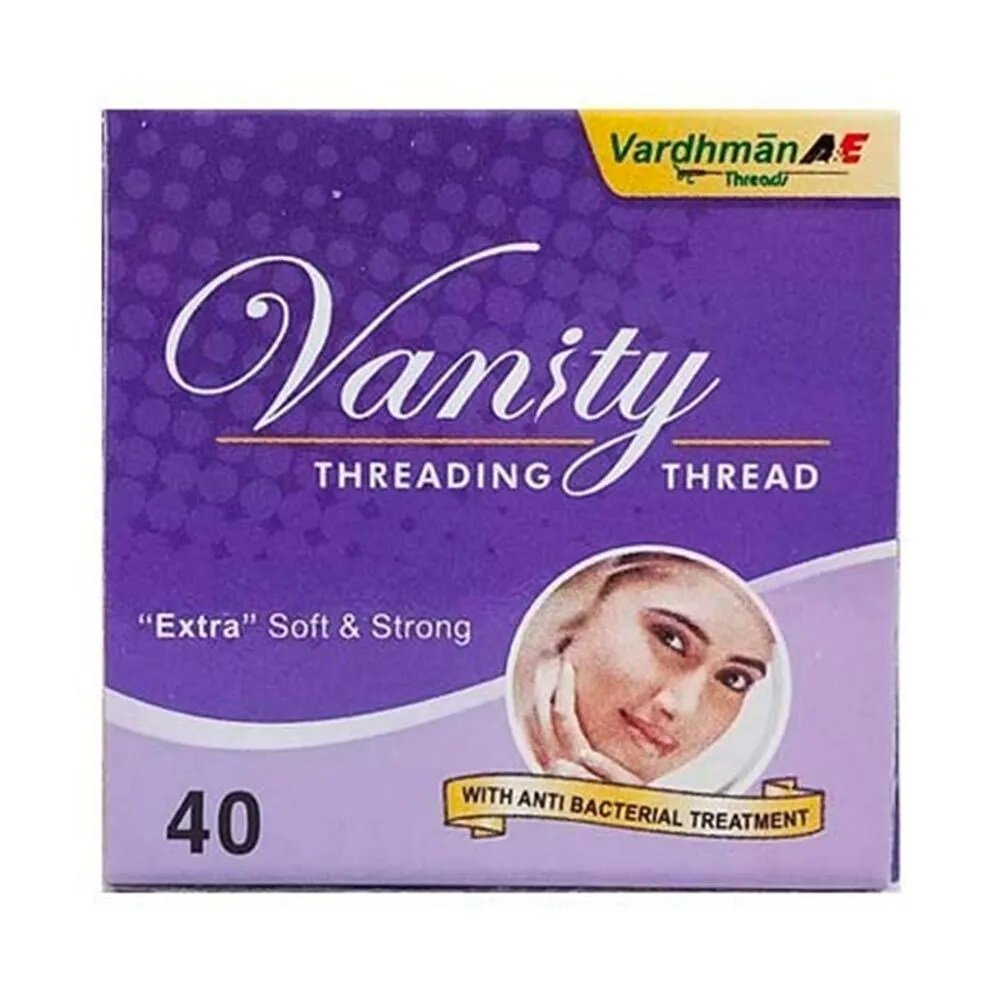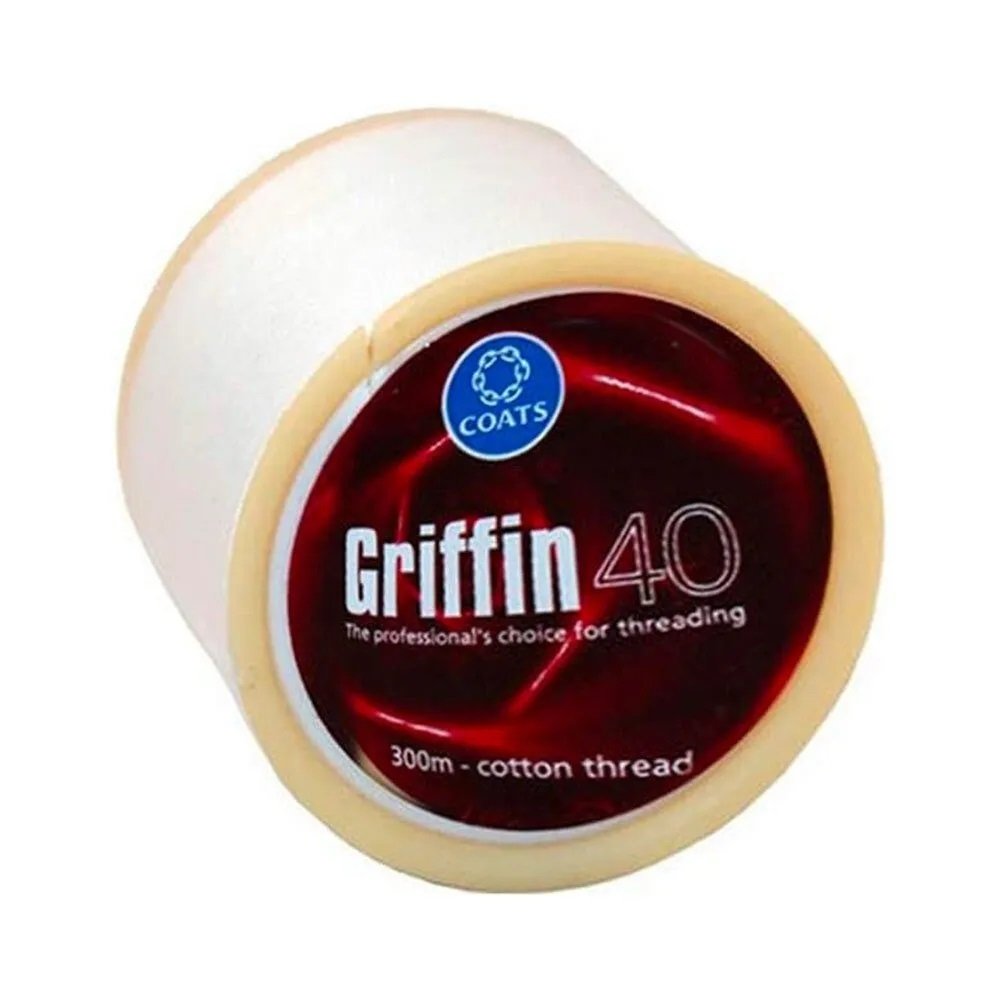Eyebrow Threading: The Ultimate Guide
All you need to know about eyebrow threading: the procedure, effects, benefits, risks, costs, and aftercare.
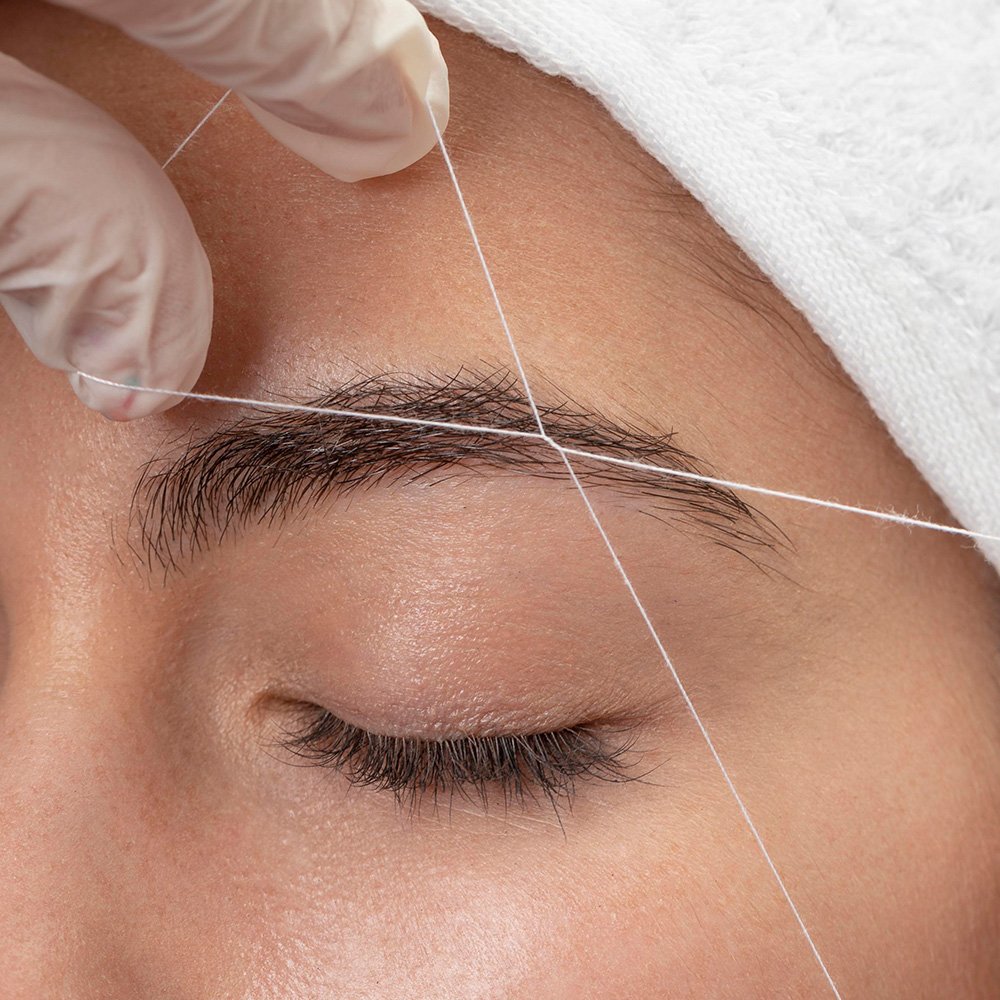
Image source : PMUhub
Explore more eyebrow grooming topics:
Eyebrow threading is a precise brow shaping technique that has become increasingly popular among people of all genders in recent years. We decided to delve into this beauty trend and collect all you need to know about it in one place.
PMUHub brings you detailed insight into the benefits, risks, costs, and the how-to of eyebrow threading.
What Is Eyebrow Threading?
Eyebrow threading is a brow grooming technique that involves using a thin thread to grasp unwanted facial hair and pull it out from the root.
It can be used to remove a line of hairs at once, but most of the time it targets specific individual hairs that spoil your perfect brow shape.
No one is certain about the origin of brows threading, but online sources variously claim that it came from India, Iran, or China, and that it has existed for thousands of years.
Whatever its starting point was, eyebrow threading has since made its way into Western beauty parlors and became a major hit. It’s performed by threading technicians a.k.a. threaders.

What Kind of Thread Is Used in Brow Threading?
A thin, gentle thread, no thicker than average sewing thread. Cotton is the standard material. Experienced threaders and people who demand quality will insist on 100% pure cotton.
Pure cotton is the best choice because it’s completely natural and therefore the safest option for any skin type. Natural materials mean less irritation and less of a chance of an allergic reaction.
If you’re wondering where to get the thread, you can find some good but affordable options on Amazon. Here are our recommendations:
What Does Threading Do to Your Eyebrows?
Okay, so now you know what it is, but you might still be wondering: what does eyebrow threading do, precisely?
Eyebrow threading is essentially a type of epilation. It removes the entire hair, including the root.
Because of the method of grasping the hair – intertwining it with thread – there’s no risk of the eyebrow hair breaking like it might when it’s grasped with tweezers or a similar instrument that only grabs one point on the hair shaft.
Once the hair is twined with the thread, it’s removed, root and all, in the direction of its natural growth. This means far less chance of ingrown hairs later on.
Eyebrow Threading Side Effects and Risks
Eyebrow threading is one of the safest cosmetic procedures out there, but, like any body modification, it has the potential for some uncomfortable effects.
The common side effects and risks of brow threading include:
- Mild irritation
- Redness
- Slight swelling
Serious side effects are very rare, but theoretically they could happen:
- A rosacea breakout (especially after full-face threading) can be triggered by excessive sweating or sun exposure after threading
- A staph infection or herpes virus spread could happen due to unsanitary treatment conditions, especially if the skin is broken
- Minor injury and bleeding if the skin is broken (nicked) due to the threader’s inexperience or inattention
For all of these reasons, it’s essential to choose your threader carefully. Take your time to research different salons and beauty parlors.
Always ask about the threader’s experience, portfolio, and try to observe them while they work.
Most importantly, make sure they adhere to sanitation guidelines and keep their workspace clean, wash their hands regularly, and never reuse the same thread on different clients.
What Are the Pros and Cons of Eyebrow Threading?
Just like any other cosmetic procedure, brow threading has its good and bad sides. Here’s a comprehensive overview to help you form your own opinion.
The Pros of Eyebrow Threading
Eye brow threading has some great upsides:
- Minimal risk of damaging the hair follicle
- Long-lasting results
- Fast (around 10 minutes with an experienced threader)
- Almost no skin contact (minimal chance of irritation to sensitive or acne-prone skin)
- Less painful than waxing or tweezing
Threading is generally regarded as less painful than waxing or tweezing, but if your skin is very sensitive or your pain tolerance is very low, your threading experience might be more uncomfortable.Of course, pain and discomfort are subjective categories.
Feel free to discuss this with your technician. They’ll adapt the pace of your appointment to minimize discomfort.
The Cons of Eyebrow Threading
Potential downsides of eye brow threading include:
- Some temporary irritation
- Technically not 100% pain-free
- Not a permanent solution to unwanted hair
Other than these minor cons, threading doesn’t really have any significant downsides as long as you choose an experienced, reputable tech.

Is Threading Better for Eyebrows Than Other Methods?
So, is threading better or worse for your brows than tweezing and waxing? In short, it’s definitely better. Threading has a few distinct benefits over the other procedures.
First off, eyebrow threading is incredibly precise. It gives you neat, subtle results, and lets you control the outline of your brow arch down to the tiniest detail.
But let’s compare the methods in more detail:
Threading vs Tweezing
Of course, plucking is precise too, but tweezers can damage your eyebrows if grasped wrong. There’s a risk of breaking the hair instead of pulling it out. There’s also the risk of damaging the hair follicle.
You could even potentially get pinched or pricked, which is never pleasant, especially if your skin is sensitive. On top of that, you’re touching the delicate skin of your face with a metal instrument, which could be tricky for people with metal allergies.
With threading, in contrast, there’s minimal contact, so sensitive skin is safe from irritation.
Threading vs Waxing
As to waxing, it falls miles behind threading in every sense. It’s not very precise and not ideally suited to the small eyebrow area. There’s more of a risk of ruining your brow silhouette.
It covers several hairs at once, so you can’t account for each hair’s growth direction. This poses the risk of ingrown hairs down the line.
In addition, even though it’s just wax, it still exposes your skin and pores to foreign chemicals. On top of everything else, wax has to be heated, so there’s a risk of getting burned – not desirable around the eyes!
NOTE
You have to be very careful about the aesthetician you choose. Though the process of eyebrow threading is simple in itself, it takes a lot of practice to get it right.
Remember, it targets individual hairs in a small area. Your threader has to be experienced, patient, and detail-oriented, with a trained eye.
Does Eyebrow Threading Hurt?
As to waxing, it falls miles behind threading in every sense. It’s not very precise and not ideally suited to the small eyebrow area. There’s more of a risk of ruining your brow silhouette.
It covers several hairs at once, so you can’t account for each hair’s growth direction. This poses the risk of ingrown hairs down the line.
In addition, even though it’s just wax, it still exposes your skin and pores to foreign chemicals. On top of everything else, wax has to be heated, so there’s a risk of getting burned – not desirable around the eyes!
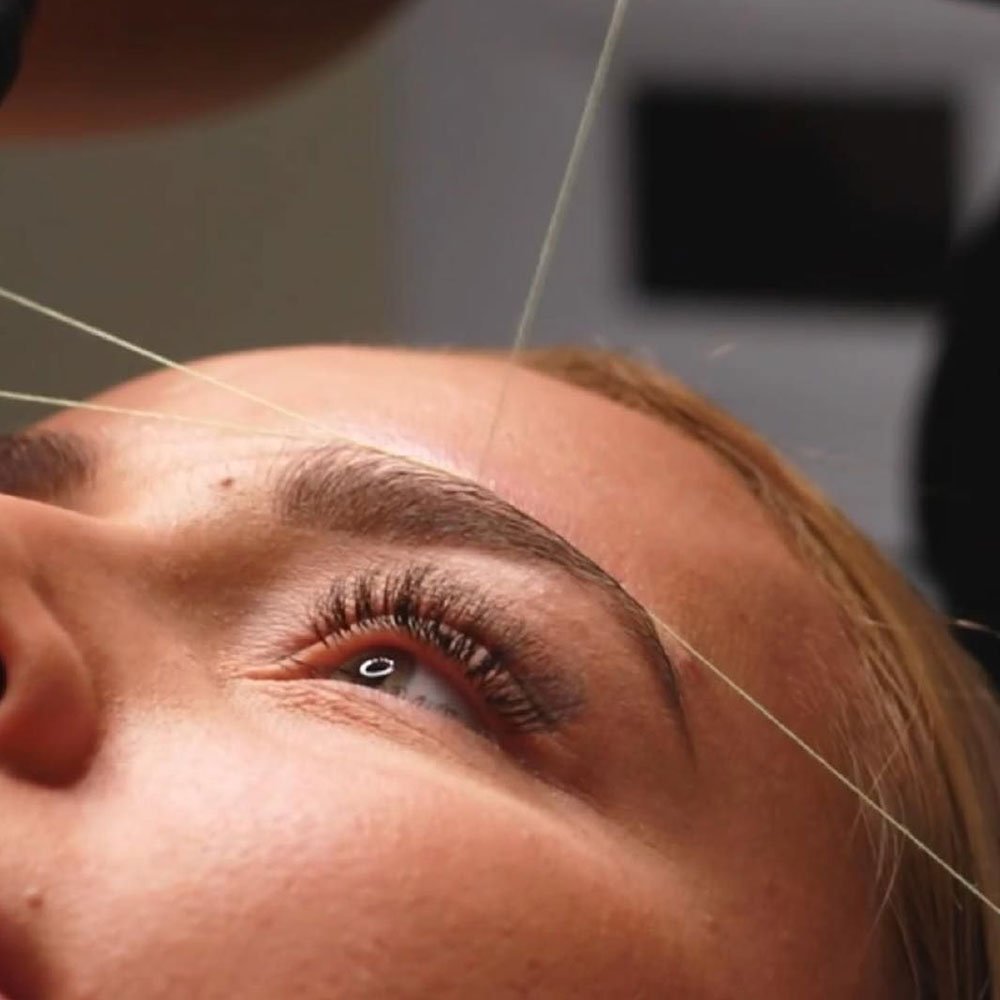
Is Eyebrow Threading Safe?
Generally yes, because the thread has minimal contact with the skin. This means virtually zero irritation and much lower risk of ingrown hairs.
That said, the skin around the eyebrows and eyes is thinner and more sensitive than elsewhere on the face or the body.
If the tech is inexperienced, inattentive, or if you’re threading on your own without sufficient practice, there’s a risk of nicking the skin and causing some bleeding. Take your time to choose a reliable threader, and be extra careful if you choose to DIY it.
Is Eyebrow Threading Safe During Pregnancy?
Eyebrow threading is generally considered safe during pregnancy, since it’s a natural procedure that involves no chemicals, doesn’t alter the body, or introduce new elements into it.
However, there are some potential drawbacks to be aware of.
Due to the hormonal changes that happen during pregnancy, hairs may grow differently (thicker or darker), which could make removal more difficult.
Additionally, skin in general may be more sensitive during pregnancy, and especially the delicate skin of the face. This could make the procedure feel more painful than before.
Pregnant women with acne should avoid threading if any of the acne is in the eye, temple, and eyebrow area, as it may accidentally cause the surrounding acne to rupture, causing pain and potentially other complications.
If you’re pregnant and would like to get your eyebrow threaded, take the safe route and clear it with your doctor and/or dermatologist first.
How to Choose a Threader
It’s important to choose an experienced, attentive tech who will do your eyebrow threading with accuracy, care, and attention to detail. They also must adhere to proper hygiene throughout. So how do you choose one?
First, make a list of salons and beauty parlors in your area that offer eyebrow threading services. Then do a little research on each. Look at online reviews, customer experiences, etc.
In addition, if you’re in the US, look up your state’s licensing requirements. Eyebrow threading is not as comprehensively regulated as some other beauty treatments, like microblading is. Some states may require a Cosmetology license for threading, while others may not.
Since these licensing requirements are highly prone to change, it’s always best to check with the relevant licensing board of your state for the most up-to-date information.
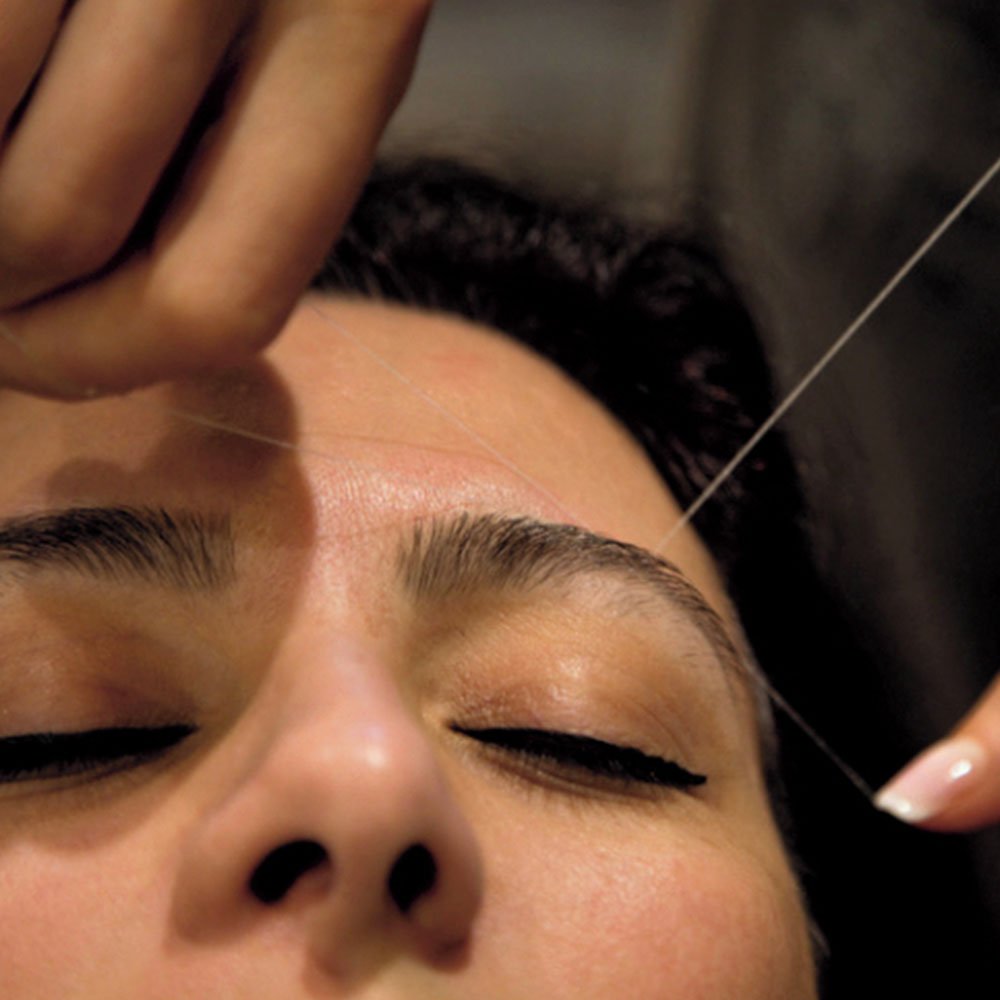
The Eyebrow Threading Process Step-By-Step
A brow threading appointment is fairly straightforward.
First, your tech will clean the skin around the eyebrow with a gentle cleanser or an alcohol wipe. This makes sure the area is disinfected, there’s no makeup or skincare product residue, and all the brow hairs are clearly visible.
Next, they’ll loop and twist a piece of thread between their hands. Your threader might ask you to place a hand on each eye in turn, to make sure your lid stays closed and the skin below the brow is sufficiently taut.
Then they’ll position the twisted section of the thread next to, or right below or above, the hair you want removed. They’ll swiftly move the twist along the thread towards the hair, trapping it and plucking it out whole in one smooth motion.
Then it’s rinse and repeat until all of the unwanted hair is gone.
NOTE
You have to be very careful about the aesthetician you choose. Though the process of eyebrow threading is simple in itself, it takes a lot of practice to get it right.
Remember, it targets individual hairs in a small area. Your threader has to be experienced, patient, and detail-oriented, with a trained eye.
How Long Does Eyebrow Threading Last?
Altogether your appointment should take less than half an hour. The more experienced your threader, the faster and more efficiently they’ll work.
But how long will eyebrow threading effects last after the appointment? The results will stay in place for several weeks.
Specifically how long depends on a few factors:
- The overall strength of your hair
- Your skin type and sensitivity levels
- Your threader’s skill
- Your natural hair growth rate
- Your hormonal profile
On average, threading done at a salon or beauty parlor should hold for 3-4 weeks, though your results might stay in place for as long as 5-6 weeks depending on all the factors we listed above.
If you do eyebrow threading at home, you should expect shorter-lasting results (2-3 weeks) until you gain experience and get better at removing the hair as a whole, without affecting the follicles.
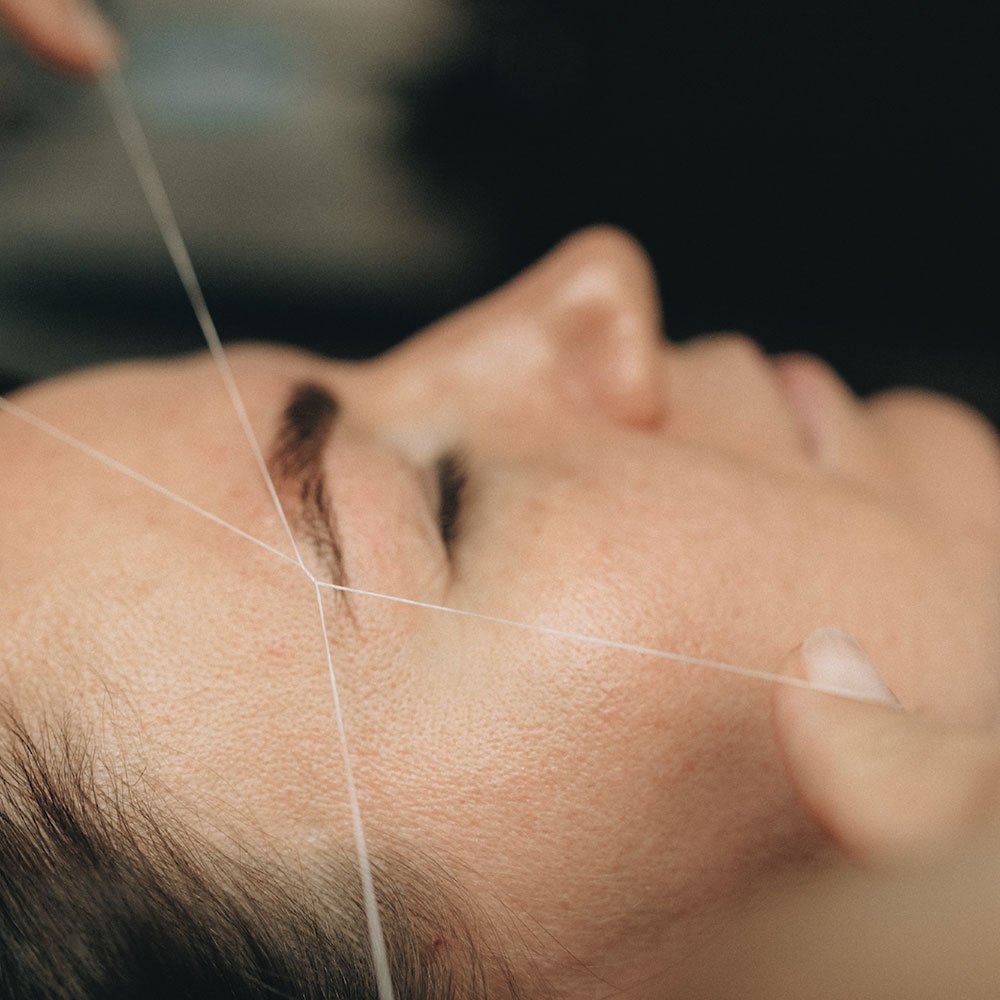
Eyebrow Threading Aftercare: What to Do After Threading Eyebrows
Although eyebrow threading requires zero downtime and zero recovery time, there are still some steps you can take to relieve any potential discomfort after your appointment.
General Aftercare
Although eyebrow threading requires zero downtime and zero recovery time, there are still some steps you can take to relieve any potential discomfort after your appointment.
Be gentle when you wash and clean the area. Use antibacterial products and stay away from any exfoliants.
If you experience discomfort or irritation, apply a cold compress, some aloe, or a cooling gel to relieve it.
If you use toner, choose one with nourishing ingredients that will help prevent infection.
- Witch hazel contains catechol tannins, which help reduce pores and push out dirt.
- Salicylic acid breaks down the oil in clogged hair follicles and helps kill bacteria.
- Chamomile, aloe vera, and allantoin are anti-inflammatory
Things to Avoid
Threading leaves your pores exposed, so avoid touching the treated area for 2-4 hours to prevent contamination.
Likewise for 2-4 hours don’t apply any makeup or perfumed skincare products to your face, and especially not on or around the eyebrows.
Avoid excessive moisture and UV exposure for at least 24 hours post-appointment. This means staying away from:
- Vigorous exercise that would make your face sweat,
- Steamy showers,
- Saunas,
- Hot baths,
- Swimming and diving,
- Sunbathing, tanning beds, or spray-tanning.
Handling Breakouts and Infections
While serious side effects such as rosacea breakouts, staph infections, and herpes virus infections are very rare, theoretically they might occur, so you should know what to do just in case.
If you have rosacea and the threading irritates your skin enough to cause it to flare up, apply an antibiotic cream, gel, or lotion to relieve it. Your usual rosacea management strategies should be enough. But if the discomfort is significant or prolonged, consult your dermatologist.
If you suspect an infection of any kind, contact your doctor immediately. They’ll run diagnostics and recommend antibiotic or antiviral treatment if necessary. Common signs of skin infections include:
- Intense redness
- Itchiness
- Swelling
- Inflammation
- Discharge
- Pain
Remember, infections shouldn’t happen if you had your eyebrow threading appointment in a sanitary space, done by an experienced aesthetician who didn’t nick your skin or traumatize your pores and follicles. That’s why it’s so essential to do your research and choose a reliable provider.
Eyebrow Threading Cost
The price range for a 10-20 minute brow threading session can be as low as $5-6, or go up to $30-45, but the average cost widely varies between locations and salons.
The cost is influenced by various factors:
- The location
- Potential additional services (like eyebrow tinting or brow lamination)
- The threader’s expertise
- Your individual needs
Competition among salons and beauty parlors in a given area can also affect the pricing of eyebrow threading. Threaders may offer lower prices to outmatch their competitors and attract more customers.
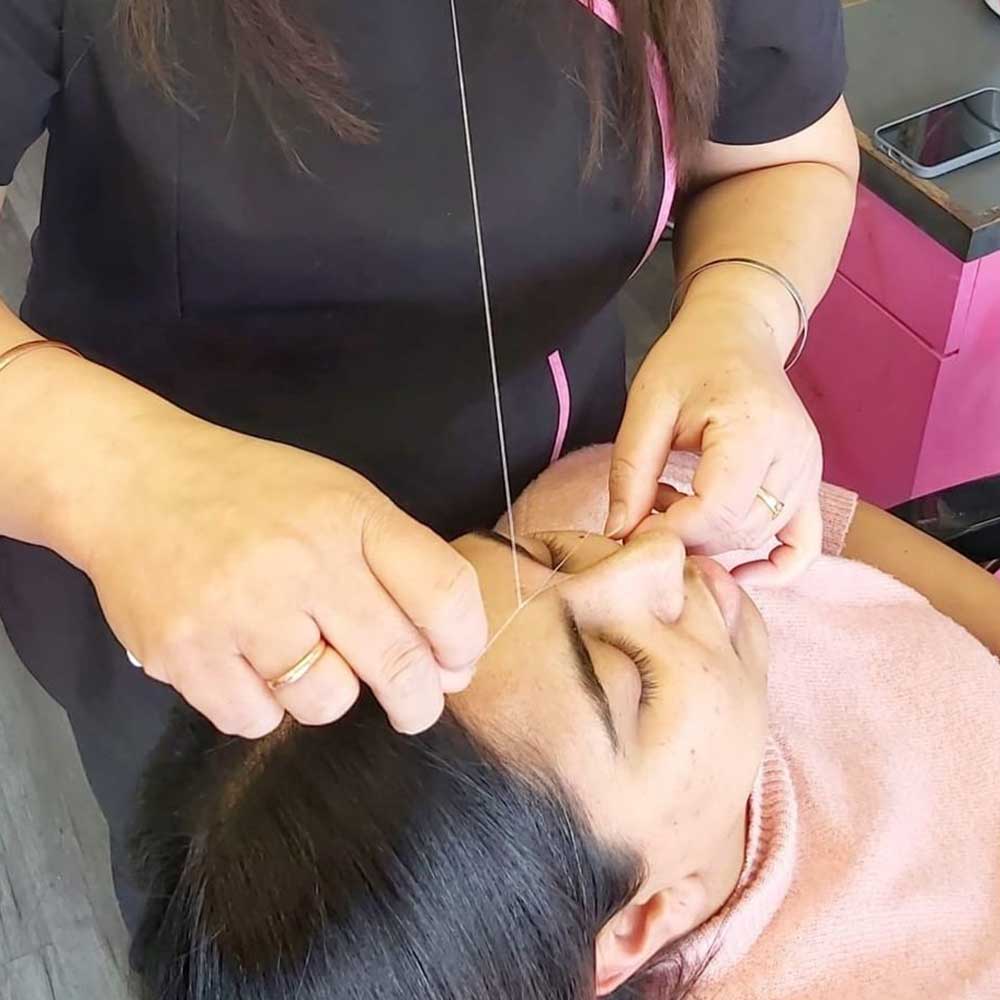
Can You Do Eyebrow Threading at Home?
Yes, but we recommend practicing on some leg hair first to get used to controlling the thread.
Here’s a step-by-step on how to do threading yourself:
Cut a length of thin cotton thread. Aim for around 11 inches (28 cm).
- People with larger hands might need more thread overall, but remember that the less string you use, the more control you will have.
- If you’re unsure about precise measurements, go the length of your forearm plus 3 extra inches (plus 7.6 cm).
Fold the thread in half and tie the ends into a knot to make a loop.
Insert two fingers into the loop on each end (palms up). Position the knot on one of your hands so it won’t be in your way when you start working.
Twist your hands in opposite directions to make an X shape with the thread loop. Twist a few more times (3-4 should do it) to make the thread twined in the middle.
Now replace your fingers: insert the thumb and forefinger of each hand into each loop. You will use them to direct and control the twined thread.
Open and close the fingers in a pinching motion, alternating between hands. This will make the twisted thread move up and down along the length of the loop. Keep alternating your pinching until you get a feel for the movement of the thread.
Aim the ‘V’ part of the thread, right before the twist, closely next to the hair you want to remove. Open the fingers of one hand to move the twist over the hair. The hair gets caught in the twist and will be pulled out from the root.
Open the fingers of the other hand to move the twist back to the middle of the thread loop. Rinse and repeat.
Eyebrow Threading – Main Takeaways
Threading is a grooming procedure that’s primarily used for shaping facial hair, specifically the eyebrows. It’s sometimes applied to upper lip hair.
It’s a highly precise treatment and therefore not efficient for removing large areas of hair on the arms, legs, or other parts of the body. However, eyebrow threading is an excellent choice for individuals who prefer subtle, detail-oriented grooming and want to keep their look clean and precise without aggressive plucking.
It’s also a good option for those who prefer simple and hygienic beauty routines, and uniquely suited to pregnant women since it doesn’t expose their sensitive skin to any substances or harsh treatment.
Threading can be incorporated into other facials and is ideal for people who receive them regularly. It can also be done alongside other brow grooming treatments, like tinting or lamination.
To ensure the best results, seek out experienced beauticians at beauty parlors that maintain proper hygiene. You can also DIY it, but be patient and practice on other body hair to get used to controlling the thread before you go anywhere near your brows.
weekly insight into PMU insdustry
Subscribe to our FREE newsletter. 100% good stuff.

support us so we can keep providing you with free education , information and inspiration.

